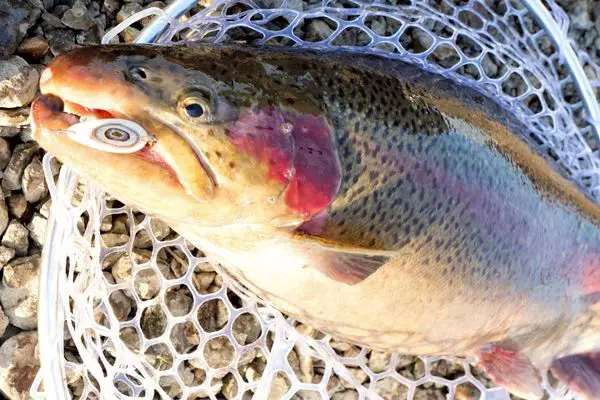I feel like spoons are somewhat under appreciated. They are becoming the forgotten lure of the trout fishing world. It is a shame, because they offer some real advantages over other designs.
Trout fishing with a spoon does not have to be difficult. You cast out, wait a few seconds to let it sink then you reel it in. You might even wiggle the rod tip a little to exaggerate the action. Could not be easier.
What I describe above is the most basic, and straightforward way to fish with a spoon. It is also basically the best, probably the only way to fish a spoon from the shore in still water. Cast out, retrieve and repeat.
But, when fishing rivers and moving water. Spoons are not a one trick pony. They can be fished in many more advance and technical ways to reach trout which might be difficult to reach otherwise.
Situations where I will reach for a spoon
Where long casts are required.
Few lures cast as well, or as far as a spoon. If I need to cover a lot of water fast, or are force to fish from only a single spot. A spoon allows me to cover more water than virtually any other trout lure.
In such situations, I do not fish just any spoon. But I reach for one which is highly aerodynamically. These are what I call long distance casting spoons. Some examples will be the ACME kastmaster, Abu Garcia Toby, Luhr-Jensen Krocodile and the Bluefox Moresilda Trout.
Fluttering spoons into deep pools.
When fishing a pool, I cast quartering upstream. I let the spoon sink quickly towards the bottom, then retrieve only slightly faster than the current. I slowly follow the path of the spoon with my rod tip. Concentrating to feel ever little bump or pause.
Ideally, the spoon will be bounce off the rocks, then flutter a bit then bounce, then flutter. This greatly resembles an injured baitfish. It pays to strike whenever a pause occurs, it might be a snag, but sometimes it is a fish.
This technique, is also a great way to find any submerge logs in a river. Expect to lose tackle, but these snag prone areas are often where the trout are holding. On hot summer days, i actually put on mast and snorkel, and swim into such deep pools. It is not uncommon to recover a handful of lures.
Pulling trout out of overhangs
Brown trout, often hide beneath overhangs. They are protected by the bank on one side, and the expanse of fast flowing water on the other.
Will, using a spoon, it is possible to sneak up to the overhang, and jig the spoon as close to the overhang as possible.
This is done by silently dropping the spoon in front of the overhang. Let the spoon sink to the bottom, then slowly jig it up and down. This can be enough to entice the trout out to strike.
It is not uncommon for a trout to strike on the drop. So always be ready to close the bail arm and set the hook.
Fishing beneath a logjam
Trout, and most predatory freshwater fish love to hold beneath logjams or under overhanging vegetation. Trout in such a position can be very difficult to cast to.
But, with a spoon, it might just be possible to reach such trout.
The only criteria, is that you have to position yourself on the bank up current of the overhang. It is also a good idea to use monofilament or flurocarbon rather than braid. Braid floats which can increase the chance of snags.
Once in position, open the bail arm and let the spoon flutter downstream in the current. The weight of the spoon, and the current will then carry the spoon under the logs. Once in place, close the bail arm, and hold it in place. Then very slowly work it back upstream.
If your spinning reel, has an anti-reverse switch. Rather than opening the bailarm, you can turn off the antireverse and back-reel the line out. This gives much more control over the speed which the spoon flutters downstream. Once the spoon is beneath the logjam, re-engage the anti reverse.
When fishing with this technique, I like try a buoyant spoon which will likely flutter with the current. A Thomas Buoyant or Acme Phoebe spoons are good choices.
Fishing Extreme shallows
Trout often lay in extremely shallow water, I suspect they choice to hold there to avoid the main flow of the river. On the retrieve spoons create more natural lift than inline-spinners, that can make them an effective option for fishing extreme shallows.
If you cast out an inline spinners, into the shallows and reel it in slowly. Chances are it will stick and rub along the bottom, snagging or becoming covered in slime.
While a spoon, even with a slow retrieve will lift off the bottom enough to be reeled in.
Which spoon to buy?
There are hundreds of spoons on the market, and they probably all catch fish. I personally recommend buying three types of spoon. The first is a long distance casting spoon, the second is a dense spoon for targeting fish in holes and finally a buoyant spoon when you might want to keep your spoon on the bottom.
For more details check what I consider to be the top 10 spoons for trout fishing here.

